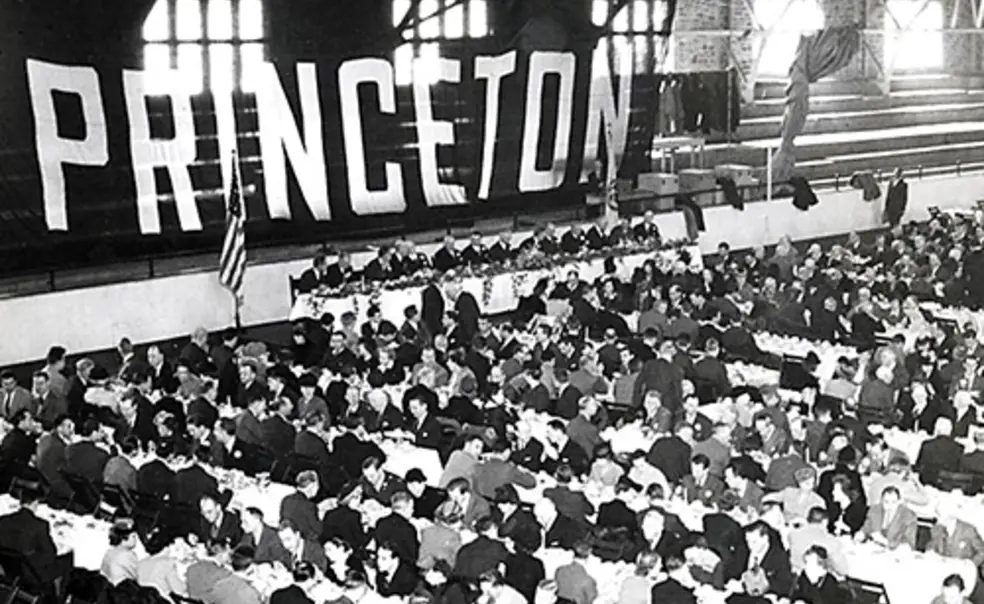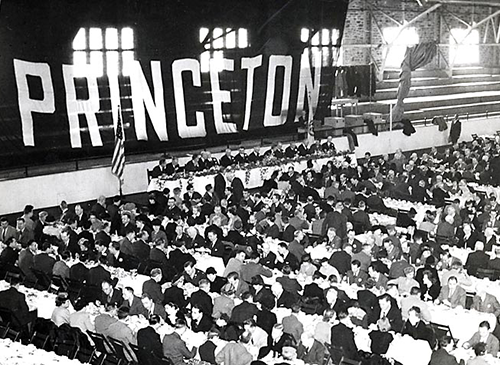Timeline: 100 Years of Alumni Day
100 Years of Alumni Day
In the last century, Princeton’s February gathering of alumni has grown from audiences of just over 100 to about 1,400 in 2014. With the 100th anniversary approaching, PAW looked back in the archives to highlight memorable Alumni Day events and images.
1915:The Tradition Begins
Reporting on the first Alumni Day, PAW saw potential for a lasting tradition: “With the day definitely placed on the university calendar and with earlier and wider publicity another year, there is reason to believe that the idea will prove contagious and that we shall have alumni coming back in large numbers to see the university at work.”
1919: A Post-War Reunion
With World War I over, alumni gathered at Princeton in large numbers. As PAW reported: “Alumni Day ... developed into a real reunion, the first Princeton has had since the war. The attendance was larger than ever before, and at all the events of the day there were ‘capacity houses.’” In his Alumni Day address, President John Grier Hibben 1882 called for radical changes to Princeton’s curriculum “of such a nature that our program of present freshman and sophomore studies may be more flexible and our entrance requirement more liberal.”
1923: New Paths for Exploration
Giving his Alumni Day address, President Hibben introduced the idea of independent study — “something that will be able to open up to [students] a gateway into some part of the field of knowledge.” Independent study, in Hibben’s words, essentially says to undergraduates: “Here is a great subject. We will help you, but we wish you to go as an explorer into this undiscovered country, to find your bearings there, and to bring back in your hands the wealth and treasure you have been able to gather.”
1933: ‘Depression or No Depression’
With the economy struggling and President Herbert Hoover nearing the end of his term in office, the nation’s outlook may have looked dim, but that did not stop an audience of about 1,000 alumni from gathering at Princeton. “Depression or no depression,” PAW reported, “it was the best attended Alumni Day, and most alumni seemed to feel it was also the most successful, in the last decade.” Pyne Prize winner F. Tremaine Billings ’33, left, received congratulations from Edward Duffield 1892, the University’s acting president.
1947: A Preview of the Marshall Plan
At least 3,500 people jammed into Baker Rink for the Alumni Day luncheon. Secretary of State George Marshall, the keynote speaker, spoke about his vision for what would become the Marshall Plan: “Most of the other countries of the world find themselves exhausted economically, financially, and physically. If the world is to get on its feet, if the productive facilities of the world are to be restored, if the democratic processes in many countries are to resume their functioning, a strong lead and definite assistance from the United States will be necessary.”
1959: $53 Million for Princeton
In what PAW called a "breath-taking announcement," President Robert Goheen ’40 *48 kicked off an intensive, three-year capital campaign to raise $53 million. The campaign, Goheen said, would place Princeton at the forefront of educational progress in America, and ensure that the University would continue to contribute to the well-being of the nation and the world. The campaign eventually raised $60.7 million, ushering in an era of unprecedented campus growth.
1963: Top Honors for Adlai
Adlai E. Stevenson II ’22, governor of Illinois and the 5th U.S. ambassador to the United Nations, was the winner of the Woodrow Wilson Award. “I am deeply honored and grateful to the committee for honoring me so richly,” he said, adding, “I am not sure what I took away from Princeton, besides the happiest memories of my life, a $1,500 check from The Daily Princetonian, and a devout reverence for Woodrow Wilson [1879].”
1972: Farewell to Goheen
The 1972 Alumni Day festivities celebrated Princeton’s final year under the direction of President Goheen, who was to retire in June after 15 years in office. At the luncheon, balcony seats at Jadwin Gym — one of the dozens of buildings build during his administration — were arranged to spell out B-O-B G-O-H-E-E-N.
1974: A Celebratory Run
As an undergraduate at Princeton, Sen. Claiborne Pell '40 used to run a four-mile course around campus three times a week. After he accepted the Woodrow Wilson Award, he changed from his brown, double-breasted suit to white gym shorts and a purple sweater to jog those same four miles. He started at Colonial Club, cruising to the Graduate College, down to Lake Carnegie, and finally sprinted the last 20 yards to the tennis courts.
1983: Top Prize for Top Presidential Aide
James Baker III ’52, then the White House chief of staff and winner of the Woodrow Wilson Award, spoke fondly of his Princeton memories to his audience at Jadwin Gym. “One important thing this institution has given us is a healthy respect for the importance of personal communication,” he said. He attributed this to the diverse educational environment at Princeton. “An ability to communicate ... is essential to success in politics and government,” he added.
1986: Like Father, Like Son
Michael Sarbanes '86 was the winner of the Pyne Prize, the highest general distinction for an undergraduate. His father, U.S. Sen. Paul Sarbanes '54, also won the same prize as an undergraduate. No other father-son duo before them had ever shared the honor. The elder Sarbanes later received the Wilson Award at Alumni Day in 2006.
1990: Jimmy Stewart Steals the Show
Jimmy Stewart ’32, the legendary actor, took home the Woodrow Wilson Award — but not before he gave a press conference, two speeches, attended a lunch, and greeted audiences everywhere he went. He spun witty anecdotes and cracked hilarious one-liners. Although a self-admitted “terrible student,” he was nonetheless lauded as one of Princeton’s greatest ambassadors by James Henderson ’56, chairman of the executive committee of the board of trustees.
1993: A Radical Vision Come True
Teach for America, the nonprofit national teacher corps founded by Wendy Kopp ’89, was born out of her senior thesis that originally had her adviser, Professor Marvin Bressler, saying, “My dear Miss Kopp, you’re quite obviously deranged.” She ended up getting an A, and the organization has since reached more than 3 million children. In receiving the Woodrow Wilson Award, Kopp said that “we must invent a whole new concept of school.”
1996: Cornel West on Race and Democracy
Cornel West *80, Princeton professor and American philosopher, was awarded the James Madison Medal. He gave a speech titled “Race Matters: Facing the Challenges of a Shared Future,” for which the audience gave a standing ovation. He spoke on the need to overcome white supremacy — no easy feat. But, he said, “I’m going down fighting.”
2005: The Magic of Invention
Madison Medalist Nathan Myhrvold *83, the former chief technology officer of Microsoft, argued that inventing can be a viable business in its own right, or at least an undertaking corporations should support. Computerized modeling and manufacturing, combined with greater connectivity and access to knowledge, could make the 21st century “an era of increasing and dynamic invention,” he said.
2014: Meeting Sonia Sotomayor
The audience at Richardson Auditorium gave a standing ovation to Supreme Court Justice Sonia Sotomayor ’76, the winner of the Woodrow Wilson Award, even before she began her speech. During the question-and-answer session, she walked amongst the audience, taking questions and posing for photos. In response to a question from a 7-year-old girl asking if she liked serving on the Supreme Court, she said, “I love being a justice. I get to meet people like you.”
Alumni Day 2015
A century after the inaugural Alumni Day, this year’s 100th anniversary celebration includes events on Friday, Feb. 20 as well as the traditional Saturday program on Feb. 21. Her Majesty Queen Noor of Jordan ’73, an advocate for humanitarian issues around the world, will receive the Woodrow Wilson Award, and Martin Eakes *80, a community organizer and economic strategist, will be awarded the James Madison Medal.












No responses yet